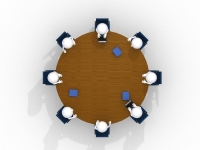 Scouters seem to be addicted to meetings. In your unit, you either conduct meetings with the youth (den and pack meetings, for instance), or hover way in the background during troop and patrol meetings. We have meetings of our own, too – committee and leader meetings, district committee and commissioner meetings, Roundtable, and all sorts of subcommittee and planning meetings.
Scouters seem to be addicted to meetings. In your unit, you either conduct meetings with the youth (den and pack meetings, for instance), or hover way in the background during troop and patrol meetings. We have meetings of our own, too – committee and leader meetings, district committee and commissioner meetings, Roundtable, and all sorts of subcommittee and planning meetings.
It seems as though our “one hour a week” doesn’t begin to include the meetings we attend, plan or participate in.
To be sure, meetings are necessary. They facilitate face-to-face communication and instant feedback from stakeholders and participants. E-mail can convey information and can be a tool for collaboration, but nothing takes the place of an in-person meeting for doing business.
And meetings are sometimes rightfully dreaded by most people who are expected to attend them. They can drag on, drift in topic and surprise participants who don’t know what to expect. It can make you feel like you’re chained to your seat without knowing how long you’ll have to endure captivity.
While everyone in a meeting shares in its success and outcomes, the meeting facilitator has the bulk of the responsibility for making sure the meeting is productive and use human resources wisely and respectfully.
If you’re a meeting facilitator – committee chair, commissioner, working group leader or trainer – there are many things you can do to help make your meetings run more smoothly and be more productive, while freeing your participants from the shackles.
- Make the best use of everyone’s time. Nobody wants to be kept in meetings any longer than necessary. We’ve covered two of the cardinal rules of meetings before: Have an agenda and stick with it, and start and end on time.
- You know that spinning beach ball or flipping hourglass on your computer that tells you little other than something might be happening? Wouldn’t you rather see a progress bar or percentage counter to let you know just how far along in the process you are? A meaningful agenda, with time allocated for each item, can serve as a progress indicator for your participants. They’ll know they’re at 50 percent if you’re halfway through the agenda, and it helps them see the light at the end of the tunnel.
Two big time-wasters and morale-killers are related: Topic drift and stray conversations.Â
- When I started as troop committee chair, our meetings would sometimes drag on because of the way the agenda was structured. We would start with reports from each committee member, and despite asking for a maximum of three minutes each, the topics being reported on frequently turned into a springboard for discussion, often with multiple tangents. After a few meetings where two-thirds of the time was taken up with reports, leaving only a few minutes for agenda items, I inverted the agenda by putting old and new business up front and reports at the end. This had two effects: we gained time to have meaningful discussions on agenda items without a lot of topic drift, and it inspired committee members to report their business briefly so we could swiftly conclude the meeting.
- A meeting I regularly attend has its share of peanut-gallery commentators. They’ll talk among themselves – well above a whisper – about their take on the topic under discussion, or they inject comments onto the floor for all to hear. These derail the momentum of the discussion that the chairman is trying to conduct, it interrupts everyone’s thoughts, and it sometimes causes others to chime in with their own comments. In cases like this, the moderator must play the bad-cop role and rein in the stray conversations for the good of the entire group. Ask people to raise their hands and be recognized if they wish to contribute, and insist that only one person – the one you’re calling on – can speak. If someone interrupts, point to them and ask them to hold their thought until the person speaking is through. Don’t be worried about making enemies because you are likely to make far more friends among those who are there to get something done and get out of there.
Meeting participants can do their share as well to ensure success.
- Come prepared for discussion if the agenda contains items that you are responsible for. Check with the chairman ahead of time if you have any doubt as to what is expected of you.
- Use your manners. Don’t carry on side conversations with your neighbors, don’t interrupt the person speaking and ask for recognition from the chair if you have something to add.
- Submit in writing anything that doesn’t require collaborative discussion or cannot be summarized in a few sentences. If you have a detailed report to give, such as a treasurer’s or advancement report, provide it ahead of time or bring printed copies, and discuss only the high points.
By refusing to accept mediocrity in meetings, you can boost the productivity of your group and improve the satisfaction of those who participate.
This post first appeared on Bobwhite Blather.




I have recently adopted un-meetings wherever possible. The un-meeting is a gathering of people that need to communicate or plan but were where we do not sit. Now, if you allow some creativity for a moment many ideas on what to do other than sit can creep in. This is the entire idea. I find these un-meetings to be more productive, speedier, and addictive… I’ve been invited to several un-meetings since I started them myself. Mr Kelly.